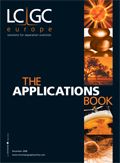Identification of Cannabinoids in Baked Goods by UHPLC–MS
The Application Notebook
Goal: Positively identify trace amounts of cannabinoids in a complex food matrix quickly, with minimal sample preparation and no chemical derivatization.
Jason R. Stenzel1 and Guifeng Jiang,2
1Washington State Patrol — Crime Laboratory Division, Cheney, Washington, USA,
2 Thermo Fisher Scientific Inc., San Jose, California, USA.
Goal: Positively identify trace amounts of cannabinoids in a complex food matrix quickly, with minimal sample preparation and no chemical derivatization.
Introduction
Marijuana is the most common illegal drug in the US and each year US law enforcement agencies seize more than two million pounds of marijuana in various forms. Seized evidence submitted to forensic laboratories is screened for marijuana. Presumptive positive results are confirmed by using gas chromatography–mass spectrometry (GC–MS) to positively identify cannabinoids. This traditional approach works fairly well for leaf marijuana, hashish, hash oil and residue collected from smoking paraphernalia.
GC–MS is less useful for confirming the presence of marijuana in complex food matrices such as baked goods. Simple sample preparation procedures using methanol or methylene chloride coextract many small molecules found in baked goods that can coelute with the target cannabinoids. Cholesterol, fatty acids and caffeine can contaminate the gas chromatograph, forcing the analyst to clean the instrument and rerun all subsequent samples.
An alternative method to positively identify marijuana cannabinoids in complex food matrices is to use ultra high performance liquid chromatography with mass spectrometry detection (UHPLC–MS). UHPLC–MS offers a three-fold benefit compared to GC–MS; simpler sample preparation, no derivatization and less instrument clean-up time.
Experimental Conditions
Brownie and cookie samples were obtained from evidence archived after adjudication. 2 mL methanol was added to 25 mg of baked-good material. This mixture was vortexed and the supernatant was filtered through a cotton-plugged Pasteur pipette. The filtrate was diluted 50-fold with methanol prior to analysis. Chromatographic analyses were performed using the Accela UHPLC system (Thermo Fisher Scientific, San Jose, California, USA). MS analysis was performed on a MSQ Plus single quadrupole LC–MS detector with Xcalibur 2.05 (Thermo Fisher Scientific, San Jose, California, USA). For the complete chromatographic and mass spectrometer conditions please refer to the complete application note.
Results
The cannabinoid standards elute with good resolution at 4.1 min (cannabidiol), 5.1 min (THC) and 5.4 min (cannabinol). The cannabinoids were detected by using full scans (50–500 m/z) of the single quadrupole mass spectrometer and the extracted ion chromatograms from m/z 310.5–311.5 + 314.5–315.5 are displayed in Figure 1(a). Molecular ions of each compound (m/z 315 for cannabidiol and THC and m/z 311 for cannabinol) are observed.

Figure 1
The brownie sample, which was taken from an adjudicated case and was known to contain THC, tested positive for THC [Figure 1(b)], demonstrating that the sample preparation required for this LC–MS method is simpler, faster and requires less sample than the GC–MS method employed for the original casework.
After 10 years in the forensic laboratory's training vault, cannabinoids in the cookie sample had degraded significantly, but by increasing the sample injection from 2 μL to 10 μL, THC was detected with good signal-to-noise [Figure 1(c)].
Conclusion
Cannabinoids in baked goods can be identified using UHPLC–MS with minimal sample preparation. The preparation time (10 min) and run time (8 min) make this a very efficient analytical method.
©2008 Thermo Fisher Scientific Inc. All rights reserved. All trademarks are the property of Thermo Fisher Scientific Inc. and its subsidiaries. This information is presented as an example of the capabilities of Thermo Fisher Scientific Inc. products. It is not intended to encourage use of these products in any manners that might infringe the intellectual property rights of others. Specifications, terms and pricing are subject to change. Not all products are available in all countries. Please consult your local sales representative for details.

Thermo Fisher Scientific Inc.
355 River Oaks Parkway, San Jose, California 95134-1991, USA
tel. +1 800 532 4752 fax +1 561 688 8731
Website: www.thermo.com/lc

Polysorbate Quantification and Degradation Analysis via LC and Charged Aerosol Detection
April 9th 2025Scientists from ThermoFisher Scientific published a review article in the Journal of Chromatography A that provided an overview of HPLC analysis using charged aerosol detection can help with polysorbate quantification.
Analytical Challenges in Measuring Migration from Food Contact Materials
November 2nd 2015Food contact materials contain low molecular weight additives and processing aids which can migrate into foods leading to trace levels of contamination. Food safety is ensured through regulations, comprising compositional controls and migration limits, which present a significant analytical challenge to the food industry to ensure compliance and demonstrate due diligence. Of the various analytical approaches, LC-MS/MS has proved to be an essential tool in monitoring migration of target compounds into foods, and more sophisticated approaches such as LC-high resolution MS (Orbitrap) are being increasingly used for untargeted analysis to monitor non-intentionally added substances. This podcast will provide an overview to this area, illustrated with various applications showing current approaches being employed.
Removing Double-Stranded RNA Impurities Using Chromatography
April 8th 2025Researchers from Agency for Science, Technology and Research in Singapore recently published a review article exploring how chromatography can be used to remove double-stranded RNA impurities during mRNA therapeutics production.












